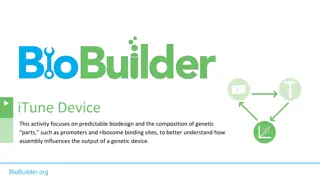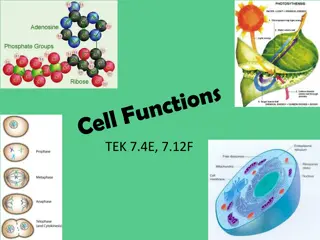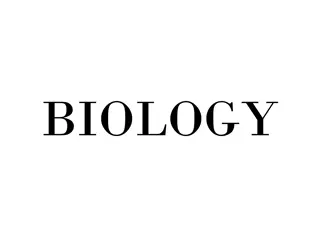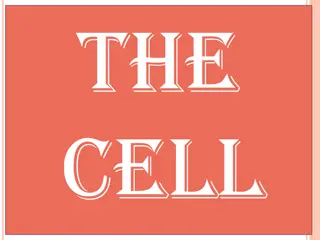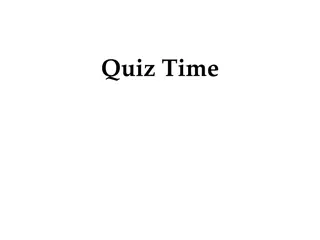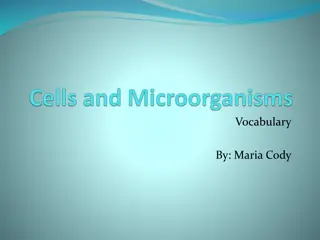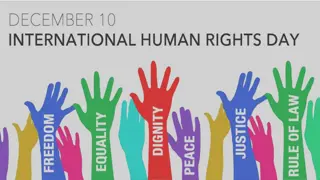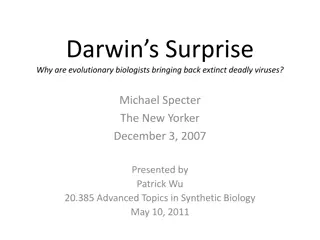Exploring the Fascinating World of Biology and Human Biology
Biology is a broad scientific field encompassing the study of living organisms and their various aspects, from anatomy and physiology to genetics and evolution. Branches of biology include anatomy, histology, cytology, physiology, embryology, genetics, molecular biology, biochemistry, zoology, botany, microbiology, ecology, and entomology. Human biology focuses specifically on the study of human anatomy, physiology, and activities such as growth, reproduction, and digestion. The organization of the human body ranges from the cellular level to the entire organism, with increasing complexity at each level.
Download Presentation

Please find below an Image/Link to download the presentation.
The content on the website is provided AS IS for your information and personal use only. It may not be sold, licensed, or shared on other websites without obtaining consent from the author. Download presentation by click this link. If you encounter any issues during the download, it is possible that the publisher has removed the file from their server.
E N D
Presentation Transcript
Biology Is the science that studies the life from all its aspects. It is including the study of living and non-living parts in life. Studying living organisms divided into many specialized fields covering their morphology, physiology, anatomy, behaviour, origin, and distribution. Biology includes many branches, such as: 1. Anatomy: is the study of the basic structure of the body of the organisms and their parts. Microscopic anatomy involves the use of optical instruments in the study of the tissues of various structures (which known as histology), and also in the study of cells.
2. Histology: is the study of the microscopic structure of tissues. 3.Cytology: is the branch of biology that studies the structure and function of cells. 4. Physiology: is the branch of biology that studies the normal functions of living organisms and their parts. It studies the function of each structure in the body and the chemical reactions occur inside the body. 5. Embryology: is the branch of biology and medicine concerned with the study of generation and the growth of embryos and their development. 6. Genetics: the branch of biology that studies the inherited characteristics of the organisms. It is also studying the variation of inherited characteristics.
7. Molecular Biology: is the study of biology at the molecular level, e.g.: studying biological molecules like DNA and RNA. 8. Biochemistry: is the study of chemical nature and sequence of biochemical reactions in organisms. 9. Zoology: is the scientific study of the behaviour, structure, physiology, classification and distribution of animals. 10. Botany: is the branch that studies the plants. 11. Microbiology: is the science that studies the microorganisms. 12. Evolution: The study that deals with the development of highly organized species from lowly organized species by a gradual change.
13. Ecology:the branch of biology that deals with the relations of organisms one to another and to their physical surroundings. 14. Entomology: The study of Insects.
Human Biology Is the study of the anatomy and all the human activities such as growth, nutrition, reproduction, respiration, digestion, excretion, secretion .etc. Studying anatomy, physiology, histology and embryology. Physiological study focuses on the systems and organs of the human body and their functions. Many systems and mechanisms interact in order to maintain the homeostasis with safe levels of substances such as sugar and oxygen in the blood. the human body involves the study of the
Organization of the Human Body The human body is organized at different levels, starting with the cell and ending with the entire organism (see the figure). At each higher level of organization, there is a greater degree of complexity.
The organization of the human body begin at the very small and basic and come together to form the complete body whose different parts work in unison. This can be seen as a kind of ladder going from the basic to the very complex. At the simplest level, the body is comprised of atoms.
The human body is composedof elements including hydrogen, oxygen, carbon, calcium and phosphorus. These elements reside in trillions of cells and non-cellular components of the body. The adult male body is about 60% water for a total water content of some 42 litres. This is made up of about 19 litres of extracellular fluid including about 3.2 litres of blood plasma and about 8.4 litres of interstitial fluid, and about 23 litres of fluid inside cells. The content, acidity and composition of the water inside and outside cells is carefully maintained. The main electrolytes in body water outside cells are sodium and chloride, whereas within cells it is potassium and other phosphates.
The most basic parts of the human body are cells, an amazing 100 trillion of them by the time the average person reaches adulthood. The human body is composed of many different types of cells that together create tissues and subsequently, ensure homeostasis and the viability of the human body. organ systems. They Generally, the human body comprises a head, neck, trunk (which includes the thorax and abdomen), arms and hands, legs and feet.
Cells Cells are the basic units of structure and function in the human body, as they are in all living things. Each cell carries out basic life processes that allow the body to survive. Many human cells specialized in form and function. Each type of these specialized cells plays a specific role. For example, the nerve cells have long projections that help them in carrying the electrical messages to other cells. Muscle cells have many mitochondria that provide the energy they need to move the body.
Tissues The tissue is the next level of organization in the human body. A tissue is a group of connected cells that have a similar function. There are four basic types of human tissues: epithelial, muscular, nervous, and connective tissues. These four tissue types make up all the organs of the human body. Connective tissue is made up of cells that form the body s structure, such as the bone and cartilage. Epithelial tissue is made up of cells that line inner and outer body surfaces, such as the skin and the lining of the digestive tract. Epithelial tissue protects the body and its internal organs, secretes substances such as hormones, and absorbs substances such as nutrients.
Muscular tissue is made up of cells that have a unique ability to contract or become shorter. Muscles attached to bones enable the body to move. Nervous tissue is made up of neurons (or nerve cells) that carry electrical messages. Nervous tissue makes up the brain and the nerves that connects the brain to all the body parts.
Organs and Organ Systems Organs are the next level of organization of the human body. An organ is a structure that consists of two or more types of tissues that work together to do the same job. Examples of human organs include the brain, heart, lungs, skin and kidneys. Human organs are organized into organ systems, many of which are shown in the figure. An organ system is a group of organs that work together to carry out a complex overall function. Each organ in the system does part of the larger job. Your body has 12 organ systems, some of them are shown below the Table.
Your organ systems do not work alone in your body. They must all be able to work together. For example, one of the most important functions of organ systems is to provide cells with oxygen and nutrients and to remove toxic waste products such as carbon dioxide. A number of organ systems, including the cardiovascular and respiratory systems, all work together to do this.
Major Organ Systems of the Human Body Major Tissues and Organs Heart; blood vessels; blood Organ System Function Cardiovascular system Transports oxygen, hormones, and nutrients to the body cells. Moves wastes and carbon dioxide away from cells. Defend against infection and disease, moves lymph between tissues and the blood stream. Digests foods and absorbs nutrients, minerals, vitamins, and water. Lymphatic system Lymph nodes; lymph vessels Digestive system Esophagus; stomach; small intestine; large intestine
Endocrine systemPituitary gland, Produces hormones that communicate between cells. hypothalamus; adrenal glands; ovaries; testes Skin, hair, nails Provides protection from injury and water loss, physical defense against infection by microorganisms, and temperature control. Involved in movement and heat production. Integumentary system Muscular systemCardiac (heart) muscle; skeletal muscle; smooth muscle; tendons
Brain, spinal cord; nerves Female: uterus; vagina; fallopian tubes; ovaries Male: penis; testes; seminal vesicles Trachea, larynx, pharynx, lungs Collects, transfers, and processes information. Produces gametes (sex cells) and sex hormones. Nervous system Reproductive system Brings air to sites where gas exchange can occur between the blood and cells (around body) or blood and air (lungs). Respiratory system
Bones, cartilage; ligaments Supports and protects soft tissues of body; produces blood cells; stores minerals. Removes extra water, salts, andwaste products from blood andbody; controls pH; controls water and salt balance. Defends against diseases. Skeletal system Kidneys; ureters; urinary bladder Urinary system Bone marrow; spleen; white blood cells Immune system
Development Development of the human body is the process of growth to maturity. The process begins with fertilization, where an egg released from the ovary of a female is penetrated by a sperm. The fertilized egg then lodges in the uterus, where an embryo and later foetus develop until birth. Growth and development occur after birth, and include both physical and psychological development, influenced by genetic, hormonal, environmental and other factors. Development and growth continue throughout life, through childhood, through adulthood to senility (ageing). adolescence, and




